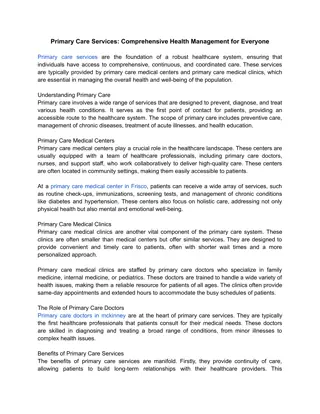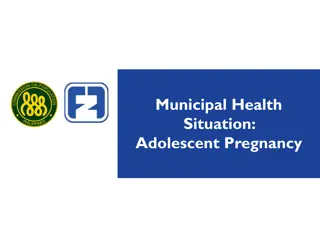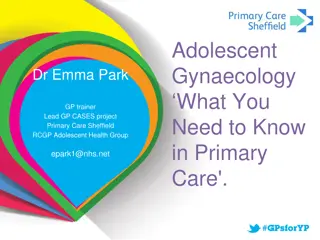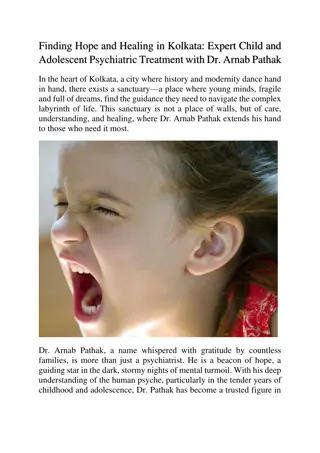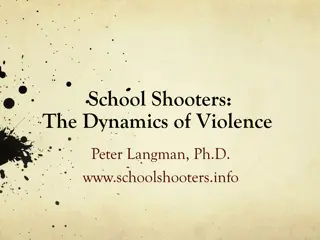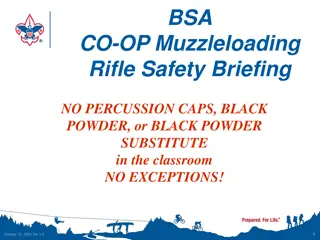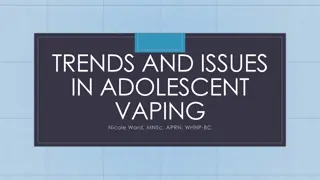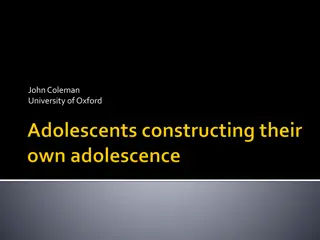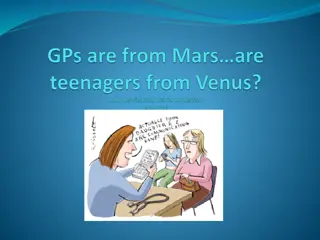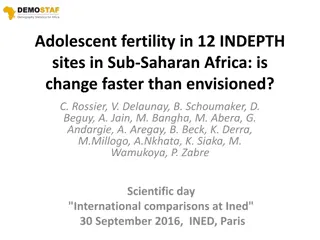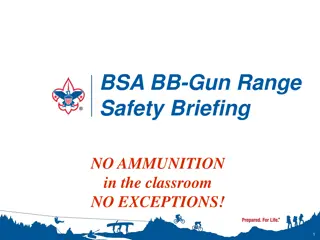Understanding Trends in Adolescent School Shooters: A Conversation with Youth Care Primary Therapists
School shootings are deeply troubling as they involve both innocent victims and young perpetrators. By addressing the emotionally charged topic of school violence, therapists aim to open a dialogue, present case studies, and discuss factors contributing to adolescent violence. The FBI emphasizes that school shootings are not solely a school or law enforcement issue but involve a complex interplay of individual, familial, and societal factors shaping a student's behavior.
Download Presentation

Please find below an Image/Link to download the presentation.
The content on the website is provided AS IS for your information and personal use only. It may not be sold, licensed, or shared on other websites without obtaining consent from the author. Download presentation by click this link. If you encounter any issues during the download, it is possible that the publisher has removed the file from their server.
E N D
Presentation Transcript
LETS HAVE A CONVERSATION ABOUT SCHOOL SHOOTERS AMY MINER, MA, LCMHCAND EMILY H. THOMAS, MS, LMFT YOUTH CARE PRIMARY THERAPISTS
AT ITS HEART. . . Two kinds of crimes upset us more than any others: crimes in which children are the victims and crimes in which children are the perpetrators. In the first case, we mourn the innocent, in the second our misapprehension that the children are innocent. School shootings are the most appalling crimes of all because they involve both problems. (Solomon, 2005)
LEARNING OBJECTIVES Objective A: Open a conversation about school shootings Look at current and past conversations that have begun Objective B: Present 2 case studies featuring would-be-perpetrators Briefly look at treatment for each case study Discuss Discharge Considerations
AS WE BROACH THIS EMOTIONALLY CHARGED TOPIC Today this is not a conversation about gun control AND means restriction is essential We are not experts We want to approach this topic with reverence, humility and concern We are simply two clinicians who are seeing more young clients who are dangerously homicidal and committed to carrying out unimaginable violence
TRENDS IN ADOLESCENT SCHOOL SHOOTERS Most incidents of targeted school violence were thought out and planned in advance Adolescent attackers share their fantasies/ plans with peers or dropped hints Adolescent attackers are more likely to have either: A partner to create a duo/ dyad The equivalent of violence coach Many engage in some form of rehearsal No one factor can be cited as the cause rather; it is a constellation of factors which can include: systemic factors, environmental factors, developmental factors, neurological factors, etc.
FBI School shootings and other forms of school violence are not just a school's problem or a law enforcement problem. They involve schools, families, and the communities. An adolescent comes to school with a collective life experience, both positive and negative, shaped by the environments of family, school, peers, community, and culture. Out of that collective experience come values, prejudices, biases, emotions, and the student's responses to training, stress, and authority. His or her behavior at school is affected by the entire range of experiences and influences. No one factor is decisive. By the same token, however, no one factor is completely without effect, which means that when a student has shown signs of potential violent behavior, schools and other community institutions do have the capacity -- and the responsibility -- to keep that potential from turning real.
TRENDS IN ADOLESCENT SCHOOL SHOOTERS Many of these youth are EXPERTS in keeping parts of their lives secret from their parents We cling to the notion that crime is the parents fault for two primary reasons. First, it is clear that severe abuse and neglect can trigger aberrant behavior in vulnerable people. . . Some parents damage their children but that does not mean that all troubled children have incompetent parents. In particular, extreme irrational crimes are not triggered by anything the parents have done. They come out of an illogic that is too profound to be instigated by trauma. Second, and far more powerfully, we want to believe that parents create criminals because in supposing that; we reassure ourselves that in our own house, where we are not doing such wrong things, we do not risk such calamity.
(2010): 575 OF SUICIDE , PSYCHOL REVE 117 (2) AL, THE INTERPERSONAL THEORY SOURCE: KIMBERLY A VAN ORDER, ET
CASE PRESENTATION: ZOEY 17 year old Caucasian female of European American decent Affluent Amicably divorced parents who were actively co-parenting Initial diagnoses Major Depressive Disorder, recurrent, severe Social Anxiety Disorder Cannabis Use Disorder Autism Spectrum Disorder, Level 1, without intellectual impairment (Five months after admission, testing for ASD testing completed) Full-Scale IQ of 102 with a processing speed of 68 (2ndpercentile) Zoey came to Youth Care after having been charged with multiple felony counts of conspiracy to commit murder
ZOEY: SEMINAL EVENTS (OCCURRING OVER APPROXIMATELY ONE YEAR) Long-term friends moved away Became friends with co-conspirator (Anna) Started using drugs Anna became Zoey s ONLY friend and they quickly became enmeshed Kicked out of theater because of offering drugs to classmates What did Anna bring to the table: Suicidal already Interested in Columbine (Erik specifically) and other school shootings Her dad was allegedly a conman and taught them how to lie Obsessed with serial killers Charles Manson, Richard Chase and Jeffrey Dahmer Sexually obsessed with Richard Ramirez ( He was cute. ) Took Spanish class and felt teacher publicly embarrassed her
ZOEY AND ANNA TOGETHER Both felt unimportant and overlooked After public shaming by Spanish teacher, Anna stated Too bad you can t kill him, and Zoey responded with Why don t/can t we? This lead to conversations about how to kill the teacher Devised a plan At some point during the planning phase, sex and violence fused for Zoey Anna documented plan in journal Anna s mother found and read the journal, called Zoey s mom Zoey s mom then read the search history on Zoey s computer and called the psychiatrist Psychiatrist reported the plan to the police Zoey and Anna were arrested and charges were filed for conspiracy to commit murder Zoey spent five weeks in an inpatient setting then came to Youth Care
TREATMENT FOR ZOEY Psychological testing/ correct diagnosis Increasing self esteem/ confidence System/ family therapy Replacing fixation Increasing positive social interactions/ peer relationships
CASE PRESENTATION: MIKE 15 year old Caucasian transgender male of European American decent Affluent Parents married Initial diagnoses Major Depressive Disorder, recurrent, severe, with Psychotic Features Social Anxiety Disorder Gender Dysphoria in Adolescents, pre-transition Unspecified Eating Disorder Full-Scale IQ of 133 with a processing speed of 123 and verbal comprehension of 142 (99.7 percentile) Mike came to Youth Care after anonymous student reported disturbing posts on deviant art and social media
MIKE: MALADAPTIVE EVOLUTION (OCCURRING OVER APPROXIMATELY ONE YEAR) Feeling unfulfilled and unimportant as she prepared to transition to High School Obsession evolved into a delusional belief that he WAS Dylan Klebold Isolating and emerging himself in online chats/ alternative social media Intent on doing it (Columbine) over to do it right this time Acquired blueprints of the school Began reading about Columbine and was introduced to Dylan Klebold Met with a contact who was selling him firearms and materials for explosives Interest in Dylan Klebold became obsessive Mapped out routes and spots to plant explosives using public transportation
TREATMENT FOR MIKE Taint the fantasy/ delusion Differentiation was critical (separating Mike and Dylan s identity ) System/ family therapy Identifying values/ interests that are about Mike Skills training focusing on anxiety management (particularly in social situations) Fostering/ practicing empathy
DISCHARGE CONSIDERATIONS The discharge paperwork itself/ prognosis Focus on risk reduction vs declaring the client safe Safety planning Appropriate aftercare For the client themselves For family members Instructions for regular assessment This includes frank and candid discussions about how to recognize relapse AND possible rehearsals for future violence **Must take great care with notifications** Law enforcement Court School Districts County threat assessment teams, etc
RISK ASSESSMENTS Despite these advances in technology, and an increase in research on clinicians predictive accuracy with adults, very little data are available concerning the accuracy of risk assessment predictions among juveniles. (Borum, 2000) The FBI recommends a 4 prong risk assessment model (FBI, 1999) Prong One: Personality of the student Prong Two: Family dynamics Prong Three: School dynamics and the student's role in those dynamics Prong Four: Social dynamics
DISCHARGE CONSIDERATIONS CONSULT, CONSULT, CONSULT DOCUMENT, DOCUMENT, DOCUMENT AND KEEP ASKING QUESTIONS
RESOURCES Recommend exploring the following: The School Shooter: A Threat Assessment Perspective (FBI, 1999) Guidelines for Responding to Student Threats of Violence (Cornell & Sheras, 2006)
RESOURCES/ SOURCE MATERIAL Dwyer, K.P., Osher, D., & Warger, C. (1998). Early warning, timely response: A guide to safe schools. Washington, DC: U.S. Department of Education (DOE) and Department of Justice (DOJ). Klebold, Sue (2016). A Mother s Reckoning. New York, NY; Penguin Random House. Fast, Jonathan (2009). Ceremonial Violence. New York, NY; The Overlook Press. Langman, Peter PhD (2009). Why Kids Kill. New York, NY; St Martins Griffin. Langman, Peter PhD (2015). School Shooters, Understanding High School, College, and Adult Perpetrators, New York, NY; Rowman & Littlefield. Lynam, D.R. (1998). Early identification of the fledgling psychopath: Locating the psychopathic child in the current nomenclature. Journal of Abnormal Psychology, 107 (4), 566-575.
RESOURCES/ SOURCE MATERIAL Malmquist, C.P. (1996). Homicide: A psychiatric perspective. Washington, DC: American Psychiatric Press. Monahan, J., & Steadman, H. J. (Eds.). (l994). Violence and mental disorder: Developments in risk assessment. Chicago: The University of Chicago Press. Secret Service and Department of Education (2002) collaborative study that can be found online:The Final Report and Findings of the Safe School Initiative: Implications for the Prevention of School Attacks in the United States and Threat Assessment in Schools; A Guide to Managing Threatening Situations and to Create Safe School Climates Kimberly A Van Orden, et al, The Interpersonal Theory of Suicide , Psychol Reve 117 (2) (2010): 575.






